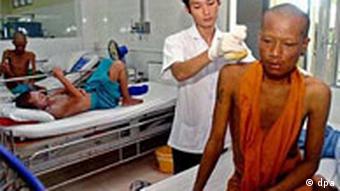HIV/AIDS is still a BIG DANGER in Thailand:
Thailand remains a favorite destination for sex tourists regardless of the high risk of HIV/AIDS.
Thai nationals are often careless about the risks of infection as many simply believe it ‘can’t happen to them.’
Thai culture encourages young people not to have any sexual experience before they are married.
But most male teenagers reaching puberty ignore social warnings or a way of life that is considered old fashioned.
According to immunologist Vicham Vithayasai, 60 percent of 15-year-olds and 80 percent of 18-year-olds already have visited prostitutes.
‘Young kids who haven’t had sex yet are teased by their friends,’ Vithayasai said. It was always possible to find a reason to have sex, whether you are taking the boss out, or visiting a new city, he said.
‘The attitude is that if you haven’t had sex there, you haven’t really been there,’ he said.
Women suffer the consequences
As in most societies Thai men believe they should be sowing their wild oats whislt their women are expected to be virgins when they marry.
For a woman to have sex before marriage is seen as an unforgivable slur on the family’s honor and reputation.
If the husbands have affairs or visit prostitutes, women often bear it silently and accept the situation.
It was too late when Karuna, a 26-year-old mother of two, realized that her husband’s affair would be fatal for her.
“I trusted him – and so I didn’t use protection,” Karuna said. Now she is HIV-positive.
In contrast to the West, AIDS in Thailand is transmitted 95 percent by heterosexuals. Thai men often infect their partners and then blame the westernization of their society for the problem.
They complain that traditional values and behavioral patterns are being eroded. The fact that it is mostly the men contributing to the spread of HIV is simply ignored.
Equal rights for men and women?
The Thai constitution guarantees men and women equal rights. Still, many of the country’s laws contradict the 1997 constitutional amendment, said Virada Somswadi, who teaches social sciences at the University of Chiang Mai. Equality in everyday life does not exist, she said.
‘Her whole life, the Thai woman has to fight her way in a blatantly patriarchal macho system,’ said Somswadi, who has been fighting for women’s rights for more than 20 years. ‘It’s a system that denies her the same rights as the men.‘
More education necessary
The first official AIDS-related illness was recorded in Thailand in 1984. In reality, the virus was already widespread in the country by then.

In 1992, Prime Minister Anand Panyarachun started the ‘100-percent condoms’ initiative.
But the government’s condom promotion was only a short-term solution to try to reduce infection rates.
They failed to back it up with programs that would properly educate men on the dangers of unprotected sexual promiscuity and, therefore, failed to convince Thai men to change their sexual lifestyles.
As long as wives continue to blindly trust their husbands, they run the risk of getting infected. Mostly they don’t understand that they are in any danger, or that using a condom considerably reduces any risk of infection.
Since HIV/AIDS was first reported, 1,115,415 adults had been infected by 2008 and 585,830 of those had died
By 2008 650,000 Thai people were living with HIV/AIDS and in 2009 1.3% of the population had been infected. This is a Thai statistic so the reality of the epidemic is likely to be very much higher than that.
By 2010 Thailand had, by far, the worst HIV/AIDS problem in Asia.
An estimated 1.3 million people in Thailand are thought to currently be HIV-positive. Half of the recent cases are women who were infected by their husbands or their partners.
Although there has been some decline in reported cases of HIV/AIDS in Thailand, this is more likely to be statistical manipulation than it is an improvement.

In fact the epidemic has moved to the general population and there is a greater need to match prevention efforts throughout the country than ever before.
Despite the efforts going into education and anti-HIV strategies, it is estimated condom use remains very low.
Recently the Department of Disease Control (DDC) estimated that 60% of sexually active teenagers and over 50% of the countries sex-workers still do not regularly use condoms.
A 2011 report from the Joint United Nations Programme on HIV/AIDS (UNAIDS) identified Thailand among the eleven countries in the Asia-Pacific with a majority of the world’s HIV-infected people.
There were 6,400 new HIV infections in Thailand in 2016. Most will have occurred through unprotected sex, which is estimated to account for 90% of all new HIV infections. Unsafe injecting drug use is the second biggest transmission route.
Increased access to prevention services has resulted in new infections decreasing among some groups, however they are rising among others.
For example, while the rate of new infections through injecting drug use steadily decreased between 1995 and 2015, the rate of new infections through male-to-male sex dramatically increased over the same period.





